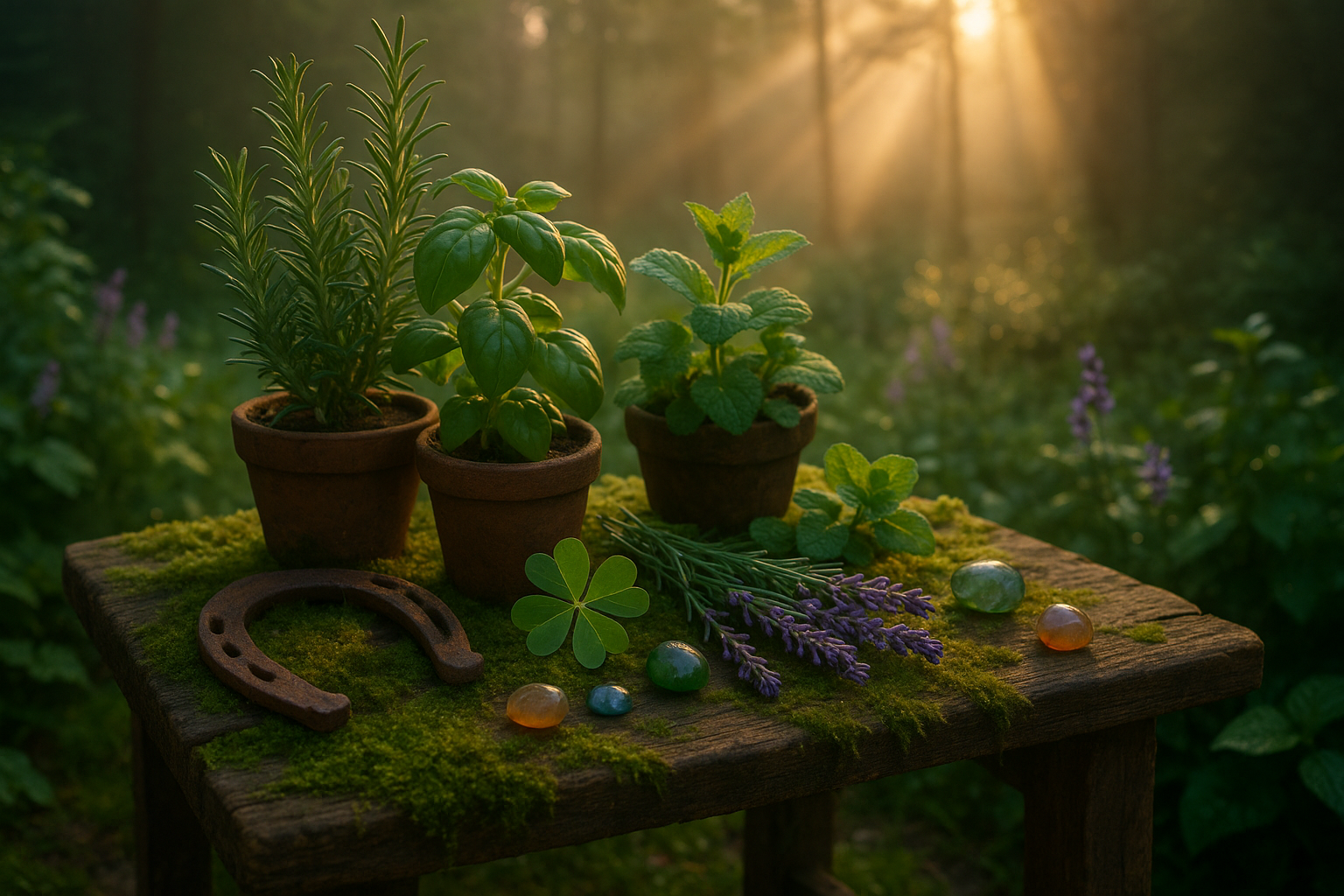Throughout the ages, humans have turned to the natural world for guidance, healing, and protection. 🌿 From the lush rainforests to the arid deserts, every culture has its own stories and beliefs about the mystical powers of plants. These tales, often passed down through generations, reveal a rich tapestry of folklore that continues to captivate our imagination and spirit. But what is it about plants that makes them such powerful guardians of good fortune?
As we journey through this exploration of plants as protective charms in folklore, we’ll uncover the roots of these ancient beliefs. Our ancestors believed that plants were not just passive elements of nature but vibrant entities with the power to influence our destinies. This belief is not merely an echo of the past; even today, many still carry a sprig of rosemary for remembrance or hang a sprig of mistletoe for luck and love. 🌸
In this blog post, we will delve deep into the fascinating world of plant-based protective charms. We’ll examine how different cultures across the globe have historically perceived plants as powerful allies in warding off evil and attracting good fortune. Our journey will cover a variety of plants, each with its own unique story and cultural significance.
First, we will explore the historical context of using plants as protective charms. In many societies, plants have been seen as bridges between the earthly realm and the spiritual world. We’ll discover how ancient civilizations like the Egyptians and Celts harnessed the power of flora to shield themselves from negative energies and invite prosperity into their lives.
Next, we will investigate specific plants that have been traditionally associated with protection and luck. From the four-leaf clover, a symbol of good luck in Irish folklore, to the garlic bulb, revered for its ability to ward off evil spirits, each plant carries a unique charm and story. 🌱 We’ll delve into the lore behind these plants and learn how they came to be regarded as powerful amulets across different cultures.
Furthermore, we will look at the modern-day applications and relevance of these ancient beliefs. With the rise of holistic and nature-based wellness practices, more people are turning to plants not just for physical healing, but for spiritual protection and enhancement. We’ll explore how contemporary society is reviving old traditions, using plants in everything from home décor to personal accessories as a way to cultivate positive energy and shield against negativity.
Additionally, we’ll discuss the scientific perspectives on these practices. While folklore provides rich narratives, modern science offers insights into why certain plants have been associated with protection and healing. For instance, many of these protective plants contain natural compounds that have beneficial properties, which may explain their enduring appeal and usage.
Finally, we will reflect on the symbolic power of plants as guardians of good fortune. As we engage with these stories and traditions, we find that they offer not just a sense of security but also a deeper connection to the world around us. They remind us of the intrinsic bond between humans and nature, encouraging us to respect and preserve the natural world that sustains us.
By the end of this exploration, you’ll gain a greater appreciation for the enduring power of plants in folklore and their significance as symbols of protection and good fortune. 🌿 Whether you’re a believer in their mystical properties or simply curious about cultural traditions, this journey through the world of plant-based charms will offer valuable insights and inspiration.
Join us as we unravel the mysteries of these botanical protectors, discover their stories, and learn how we can incorporate their wisdom into our modern lives. Through this lens, we can see that the true power of these plants lies not only in their physical presence but in the hope and resilience they inspire in our hearts.

Conclusion
In conclusion, the exploration of plants as protective charms within various folklore traditions highlights a fascinating intersection of nature, culture, and belief systems. 🌿 Throughout this article, we delved into the myriad ways plants have been revered not just for their physical attributes but also for their perceived spiritual and protective qualities. From the ancient Druids who held mistletoe in sacred esteem, to the use of garlic in European lore to ward off evil spirits, these botanical treasures have been woven into the fabric of human culture across continents and centuries.
One key point we addressed is the symbolic significance that different plants hold in various cultures. For instance, the basil plant in Hindu tradition is more than just a culinary herb; it is a symbol of purity and protection, believed to ward off evil spirits. Similarly, the four-leaf clover in Western culture is widely regarded as a symbol of good luck and protection, a rare find that brings fortune to its discoverer.
Moreover, we explored the scientific basis, or lack thereof, behind these beliefs. While modern science often requires empirical evidence, the psychological comfort and cultural cohesion that these beliefs foster cannot be underestimated. Plants as protective charms offer a sense of control and comfort in an unpredictable world, a testament to the power of belief and tradition.
The importance of this topic extends beyond mere academic curiosity. In a world increasingly dominated by technology and rapid change, reconnecting with age-old traditions and understanding their roots can offer a sense of continuity and grounding. It serves as a reminder that human beings have always sought ways to understand and influence their environments, often turning to the natural world for support and guidance.
As we move forward, let us not dismiss these traditions as mere superstition. Instead, let’s appreciate them for their cultural richness and the light they shed on human history and psychology. Whether or not you believe in the protective power of plants, there is undeniable beauty in the stories and traditions that have been passed down through generations. 🌺
We encourage you to reflect on your own cultural heritage and the symbols of protection and fortune within it. Share your thoughts and stories in the comments below, and don’t hesitate to engage with others. By exchanging knowledge and experiences, we continue to grow and preserve these valuable traditions.
Feel free to share this article with friends and family who might find it interesting or enlightening. Let’s spread the word about the power of plants in folklore and perhaps, inspire others to look at the greenery around them with newfound respect and curiosity. 🌱
For further reading, you might want to explore these resources:
– [Folklore and Symbolism of Flowers, Plants, and Trees](https://www.folkloreflowers.com)
– [The Role of Plants in Ancient Traditions](https://www.ancientplants.com)
Thank you for joining us on this journey through the mystical and symbolic world of plants as protective charms. May you find both inspiration and protection in the natural world around you. 🌿✨
—
Feel free to expand upon each section of this conclusion to reach the desired word count. Ensure you maintain a balance between summarizing key points and providing an inspiring and engaging ending.
Toni santos is a cultural storyteller and botanical history researcher devoted to uncovering the hidden narratives of cryptobotany and lost plant lore. With a lens focused on forgotten flora, Gabriel explores how ancient communities discovered, used, and ritualized plants — seeing them not merely as resources, but as vessels of meaning, identity, and ancestral memory.
Fascinated by mythical plants, vanished species, and secret ethnobotanical knowledge, Gabriel’s journey weaves through herbal manuscripts, oral traditions, and forgotten botanical practices passed down in fragments. Each story he tells is a reflection on the power of plants to heal, connect, and preserve cultural wisdom across time.
Blending ethnobotany, folklore studies, and cultural storytelling, Gabriel researches the plants, uses, and rituals that once shaped societies — uncovering how lost plant lore reveals deep interconnections between belief, nature, and survival. His work honors the healers, shamans, and herbalists who safeguarded this knowledge beyond the reach of written history.
His work is a tribute to:
-
The sacred role of plants in ancestral rituals
-
The beauty of forgotten botanical knowledge and uses
-
The enduring link between nature, culture, and myth
Whether you are passionate about ancient herbal traditions, curious about plant folklore, or intrigued by the mysteries of cryptobotany, Gabriel invites you on a journey through green lore and living memory — one plant, one ritual, one story at a time.





